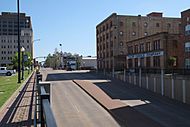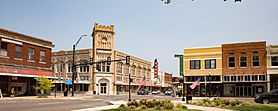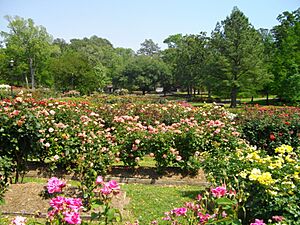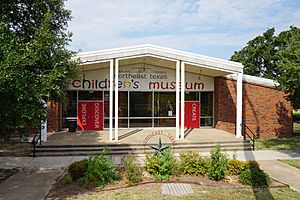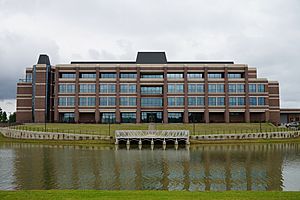Northeast Texas facts for kids
Quick facts for kids
Northeast Texas
|
|
|---|---|
|
|
|
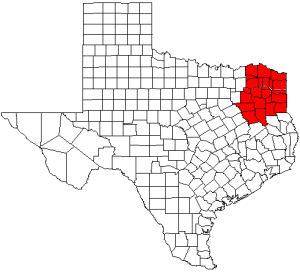
Northeast Texas counties in red
|
|
| Country | |
| State | |
| Largest city | Tyler |
| Population
(2020)
|
|
| • Total | 1,152,223 |
Northeast Texas is a special area in the northeastern part of Texas. It's known for its unique culture and geography. The main cities here are Tyler and Longview/Marshall, which are connected by Interstate 20. Other important cities include Greenville, Mount Pleasant, Sulphur Springs, Paris, and Texarkana. These cities are mostly found along Interstate 30. To the south, you'll find Jacksonville and Palestine.
Northeast Texas is different from other parts of East Texas. It's not strongly influenced by big cities like Dallas or Houston. This makes it feel a bit more separate. Even though it's a large area, it might not be as well-known as smaller towns closer to Dallas or Houston.
In the past, cities like Marshall and Jefferson were very important. They helped lead Texas into the Confederate States of America. Before Texas became a state, Nacogdoches and San Augustine were the most developed cities. Nacogdoches even rebelled against Mexican rule in the Fredonian Rebellion. Many cities in Northeast Texas still have a rural, Southern way of life. This can be seen in how people talk, their customs, their religion, and their food.
Contents
Exploring Northeast Texas Geography
The land in Northeast Texas is mostly covered by the Piney Woods. This is a mixed forest with both deciduous (trees that lose leaves) and conifer (evergreen) trees. The Piney Woods cover about 23,500 square miles (60,865 square kilometers). This area has gently rolling hills and lots of trees. These woods are part of a much bigger forest that stretches into Louisiana, Arkansas, and Oklahoma. Northeast Texas is part of the Gulf Coastal Plain. It gets more rain than other parts of Texas, usually between 35 to 50 inches (890 to 1270 mm) each year.
The Sabine River is a major river in Northeast Texas. It flows through Longview and other cities. The Red River also runs through the region. It forms the northern border with Oklahoma and part of Arkansas. In this region, small rivers and creeks flow into swampy areas called "bayous." These bayous blend with the surrounding forest. Bald cypress trees and Spanish moss are common plants in bayous. The most famous bayou here is the Big Cypress Bayou. It surrounds the Big, Little, and Black Cypress Rivers near Jefferson. These rivers flow into Caddo Lake, which is surrounded by wetlands.
Some of the big lakes in Northeast Texas include Jim Chapman Lake, Lake Tawakoni, Lake Fork, Cedar Creek Reservoir, Pat Mayse Lake, Lake Palestine, Caddo Lake, Lake O' the Pines, and Wright Patman Lake.
The weather in Northeast Texas is warmer and wetter than most of Texas. The land is also more hilly and forested. Its culture is similar to Southeast Texas, but it doesn't have as much of a Cajun influence.
Counties of Northeast Texas
Here are the 23 counties that make up Northeast Texas:
Largest Cities in Northeast Texas
Here are some of the biggest cities in Northeast Texas, based on their population in 2020:
| City | Population (2020) |
|---|---|
 Tyler |
105,995 |
 Longview |
81,638 |
 Texarkana |
36,193 |
 Paris |
24,476 |
 Marshall |
23,392 |
 Palestine |
18,544 |
 Mount Pleasant |
16,047 |
 Sulphur Springs |
15,941 |
 Jacksonville |
13,997 |
 Kilgore |
13,376 |
 Henderson |
13,271 |
 Athens |
12,857 |
Culture and Traditions
The culture of Northeast Texas is quite similar to that of Arkansas, Louisiana, and even Mississippi. This area is part of the "Bible Belt," which means Christianity is very important to many people.
Many traditions in modern Northeast Texas have been passed down for generations. One popular event is the First Monday Trade Days in Canton, Texas. This huge outdoor market happens on the Thursday through Sunday before the first Monday of each month. It's said to be the oldest and largest continuously running flea market in the United States.
The East Texas Oil Museum is located at Kilgore College in Kilgore, Texas. It shows how oil was discovered and produced in the 1930s. This was when the largest oil field in the U.S. was found here.
Tyler is known as the "Rose Capital of America." This is because a lot of the commercial rose bushes in the U.S. are grown there. More than half of the rose bushes sold are packaged and shipped from the Tyler area. Tyler also has the nation's largest public rose garden. Every October, it hosts the Texas Rose Festival, which attracts over 100,000 visitors.
The Northeast Texas Children's Museum is in Commerce. It offers fun and creative learning experiences for kids in the area. Many schools from the Dallas/Fort Worth Metroplex and Northeast Texas visit the museum on field trips.
Economy of Northeast Texas
The economy of Northeast Texas is mainly focused around the Tyler and Longview areas. These cities are part of the larger Ark-La-Tex region, which also includes the Texarkana metropolitan area.
In the Tyler and Longview areas, you'll find companies like Brookshire Grocery Company, which owns Brookshire's and Super1Foods grocery stores. Other big companies with a presence here include Synthesizers.com, Eastman Chemical, AAON Coil Products, AT&T, and Walmart.
Higher Education Opportunities
Northeast Texas has many colleges and universities. These include The University of Texas at Tyler, Texas A&M University at Commerce, and Texas A&M University at Texarkana. You can also find Stephen F. Austin State University in Nacogdoches, East Texas Baptist University, and LeTourneau University.
There are also eight public and two private community colleges. A branch of the Texas State Technical College is in Marshall. The region also has three historically black colleges and several private colleges connected to churches. All the public colleges and universities work together through the Northeast Texas Consortium of Colleges and Universities. This group helps provide more degree and course options.
Community colleges in Northeast Texas started as "junior colleges." They focused on providing the first two years of a college degree. Later, most added technical programs with associate of applied science degrees. However, they still strongly focus on liberal arts and academic associate degrees. Many of these colleges have sports teams, including football, and offer dorms. They are also known for their "high kicking" drill teams.
Some community colleges in the region are Kilgore College, Paris Junior College, Northeast Texas Community College near Mt. Pleasant, Texarkana College, Panola College in Carthage, Tyler Junior College, Trinity Valley Community College in Athens (with campuses in Terrell and Palestine), and Angelina College in Lufkin. Jacksonville has two smaller private two-year colleges: Jacksonville College (Baptist) and Lon Morris College.
Transportation in Northeast Texas
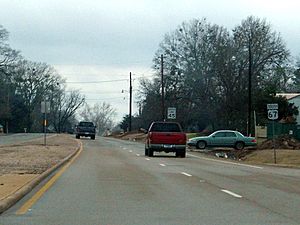
Major highways and interstates help people travel through Northeast Texas:
 Interstate 20
Interstate 20 Interstate 30
Interstate 30 Interstate 369
Interstate 369 U.S. Highway 59
U.S. Highway 59 U.S. Highway 67
U.S. Highway 67 U.S. Highway 69
U.S. Highway 69 U.S. Highway 79
U.S. Highway 79 U.S. Highway 80
U.S. Highway 80 U.S. Highway 82
U.S. Highway 82 U.S. Highway 84
U.S. Highway 84 U.S. Highway 175
U.S. Highway 175 U.S. Highway 259
U.S. Highway 259 U.S. Highway 271
U.S. Highway 271 U.S. Highway 287
U.S. Highway 287
Images for kids



